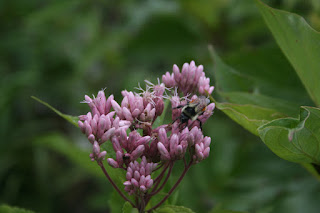You get an appreciation for the hardiness and tolerance of some plants like this Spotted Joe-pye-weed (Eupatorium maculatum) hanging on in a rock crevice. The roaring spring freshet flows
Shrubby Cinquefoil (Dasiphora fruticosa) and Poverty Oats Grass (Danthonia spicata).
Blueflag Iris (Iris versicolor), seemingly out of place but with roots deep enough to reach the moist soils it requires.
Kalm's Lobelia (Lobelia kalmii) does well in the gravelly wet depressions.
Orange-belted or Tricoloured Bumble Bee (Bombus ternarius) were spotted throughout the beaver meadows and especially on the Joe-pye-weed.
One sandy spit had an abundance of interesting-looking driftwood.
With a canoe over your head and a few back and forth trips down the portage trail I spotted this Ladies' Tresses orchid. Similar to the driftwood in the last photo, the flowers of species in the Spiranthes genus tend to curl around the stem. Identification to species usually requires the flower to look at length, shape and colour of various parts.
Groups of Common Goldeneye ducklings on the river would scurry off into small channels for shelter. The trip also included an encounter with a family of River Otter; chirping us from a distance, one got brave, swam rapidly at our canoe and greeted us with a thump.














No comments:
Post a Comment